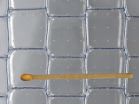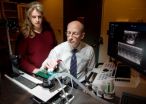(Press-News.org) This press release is available in Spanish.
Amino acids in orange juice might reveal secrets to the successful attack strategy of the plant pathogen that causes citrus greening disease, also known as Huanglongbing or HLB. Studies of these amino acids by U.S. Department of Agriculture (USDA) chemist Andrew P. Breksa III and University of California-Davis professor Carolyn M. Slupsky may pave the way to a safe, effective, environmentally friendly approach to undermine Candidatus Liberibacter asiaticus, the microbial culprit behind HLB.
The scientists used nuclear magnetic resonance spectroscopy to study the amino acid composition of juice from oranges grown on HLB-positive or HLB-negative trees. Their investigation is apparently the first to use this technology for that purpose, according to the researchers.
The study yielded distinctive profiles of the kinds and amounts of 11 different amino acids in three types of oranges: fruit from healthy trees; symptom-free fruit from HLB-positive trees; and fruit, with HLB symptoms, from HLB-positive trees.
With further research, the profiles may prove to be a reliable, rapid and early indicator of the presence of the HLB pathogen in an orchard, according to Breksa. He is with the Agricultural Research Service (ARS) Western Regional Research Center in Albany, Calif. ARS is the USDA's chief intramural scientific research agency, and this research supports the USDA priority of promoting international food security.
Breksa also noted that the profiles may reveal clues to mechanisms underlying the microbe's mostly unknown mode of attack. For instance, if the HLB pathogen were causing havoc with the trees' ability to create, use and recycle amino acids, scientists might be able to use that information as a starting point for a counterattack strategy.
Phenylalanine may be a case in point. An orange tree can convert this amino acid into cinnamic acid, a precursor to compounds thought to be important to the tree's defense system. But the researchers found that juice squeezed from oranges of HLB-positive trees had significantly higher concentrations of phenylalanine, which suggests that the HLB pathogen may have interfered with the tree's conversion of phenylalanine to cinnamic acid.
###Read more about this research in the January 2013 issue of Agricultural Research magazine.
http://www.ars.usda.gov/is/AR/archive/jan13/juice0113.htm
USDA is an equal opportunity provider and employer. To file a complaint of discrimination, write: USDA, Office of the Assistant Secretary for Civil Rights, Office of Adjudication, 1400 Independence Ave., SW, Washington, DC 20250-9410 or call (866) 632-9992 (Toll-free Customer Service), (800) 877-8339 (Local or Federal relay), (866) 377-8642 (Relay voice users).
Amino acid studies may aid battle against citrus greening disease
2013-01-14
ELSE PRESS RELEASES FROM THIS DATE:
ASH international clinical collaboration replicates high cure rate of APL in developing countries
2013-01-14
(WASHINGTON) – Data published online today in Blood, the Journal of the American Society of Hematology (ASH) describe the work of an ASH international clinical network collaborative focused on modernizing treatment protocols for patients in the developing world with acute promyeloctyic leukemia (APL) that has drastically improved cure rates in patients in Central and South America, achieving comparable outcomes to those observed in patients in the United States and in Europe.
APL is a rare, aggressive cancer of the blood and bone marrow that can be fatal in a matter ...
Better care from doctors who are culturally aware
2013-01-14
HIV patients from ethnic minorities receive better quality of care from doctors and other primary healthcare professionals who are the most competent at caring for patients from diverse backgrounds – those who are "culturally competent." These patients also tend to manage both their treatment and condition better, according to a new study¹ by Somnath Saha from Portland VA Medical Center, and the Oregon Health & Science University in the US, and colleagues. Their findings appear in the Journal of General Internal Medicine², published by Springer.
The authors explored whether ...
The secret sex life of the penicillin-producing fungus could make it more productive
2013-01-14
New and more effective strains of the fungus used to produce penicillin could be developed after a team of international scientists unearthed the secret sex life of Sir Alexander Fleming's fungus Penicillium chrysogenum (P. chrysogenum).
The scientists from The University of Nottingham, Ruhr-University Bochum, The University of Göttingen, and Sandoz GmbH have announced a major breakthrough in our understanding of the sex life of the fungus P. chrysogenum. Their research looks sets to lead to the introduction of new and more effective strains of the world's first antibiotic ...
Parkinson's treatment can trigger creativity
2013-01-14
Parkinson's experts across the world have been reporting a remarkable phenomenon — many patients treated with drugs to increase the activity of dopamine in the brain as a therapy for motor symptoms such as tremors and muscle rigidity are developing new creative talents, including painting, sculpting, writing, and more.
Prof. Rivka Inzelberg of Tel Aviv University's Sackler Faculty of Medicine first noticed the trend in her own Sheba Medical Center clinic when the usual holiday presents from patients — typically chocolates or similar gifts — took a surprising turn. "Instead, ...
Team finds gene that promotes drug resistance in cancer
2013-01-14
Scientists from the University of Iowa and Brigham Young University (BYU) have identified a gene that may be a target for overcoming drug resistance in cancer. The finding could not only improve prognostic and diagnostic tools for evaluating cancer and monitoring patients' response to treatment but also could lead to new therapies directed at eradicating drug-resistant cancer cells.
Drug resistance is a common problem in many metastatic cancers. It leads to failure of chemotherapy treatments and is associated with poor patient outcomes, including rapid relapse and death.
The ...
American College of Physicians calls for immunizations for all health care providers
2013-01-14
PHILADELPHIA, January 14, 2013 -- The American College of Physicians (ACP) has approved a policy recommendation that all health care providers (HCPs) be immunized against influenza; diphtheria; hepatitis B; measles, mumps, and rubella; pertussis (whooping cough); and varicella (chickenpox) according to the Advisory Committee on Immunization Practices (ACIP) Adult Immunization Schedule. ACP's policy exempts HCPs for medical reasons or a religious objection to immunization.
"These transmissible infectious diseases represent a threat to health care providers and the patients ...
Are some patients too heavy for a new kidney?
2013-01-14
ST. LOUIS – In a research review article published in the American Journal of Nephrology, Saint Louis University investigators examined data from multiple studies to better understand how obesity, an epidemic in the U.S., impacts kidney transplant patients. The authors report that, even as some connections between weight and health outcomes are unknown or contradictory, there is evidence that obese kidney transplant patients don't do as well after surgery, experiencing more adverse outcomes, including wound infections, delayed graft function, graft failure, cardiac disease ...
Noise protection – multifunctional and aesthetical
2013-01-14
Too much noise causes illness. This is as an undisputed fact nowadays, and yet we're still constantly assailed by noise as we go about our daily lives, be it from traffic or voices in large open-plan offices. Noise pollution can be reduced with the help of structural solutions; we've all seen noise barriers along busy roads and train lines, and there are special acoustic structural components, so-called sound absorbers, which are used inside buildings to keep noise levels down. But there's a problem. The construction components used up until now may well be effective at ...
Can acupuncture improve exercise performance and post-exercise recovery?
2013-01-14
New Rochelle, NY, January 14, 2013—The effects of acute acupuncture applied during exercise on performance factors such as power and blood pressure and on the body's ability to recover post-exercise were evaluated in a review article published in The Journal of Alternative and Complementary Medicine, a peer-reviewed journal from Mary Ann Liebert, Inc., publishers. The article is available free on the Journal website at http://www.liebertpub.com/acm.
A review of the literature uncovered four studies designed to test whether a person receiving acupuncture while exercising ...
Stem-cell approach shows promise for Duchenne muscular dystrophy
2013-01-14
CHAMPAIGN, Ill. — Researchers have shown that transplanting stem cells derived from normal mouse blood vessels into the hearts of mice that model the pathology associated with Duchenne muscular dystrophy (DMD) prevents the decrease in heart function associated with DMD.
Their findings appear in the journal Stem Cells Translational Medicine.
Duchenne muscular dystrophy is a genetic disorder caused by a mutation in the gene for dystrophin, a protein that anchors muscle cells in place when they contract. Without dystrophin, muscle contractions tear cell membranes, leading ...



